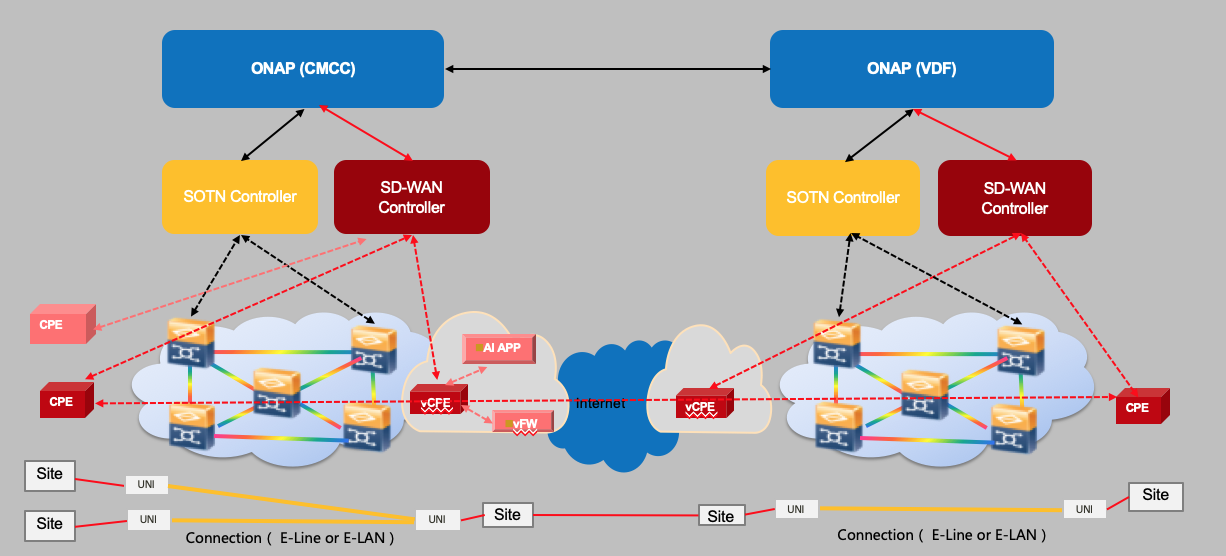| Table of Contents |
|---|
Use Case Authors:
China Mobile, Vodafone, Huawei, ZTE, VMWare, Intel, WindRiver, China Telecom, Fujitsu, Lenovo
...
Service Procurement (SP)
The enterprise HQ may want to order a VPN stretch between two or more branch sites, they may also want other value added services bind with the VPN service. A customer facing portal is provided under this condition so that a customer can choose which sites to set the VPN service and combine what kind of value added service with the VPN service, as well as provide other customized needs of the service like the bindwidth and duration without knowing the deployment details and VPN parameters. We call this process as service procurement and a service order is placed at this phase.Service Instantiation (SI)
After the service order is obtained, another page will pop out for users to finish other detailed inputs of CCVPN parameters so that a CCVPN service can be instantiated and deployed by ONAP.Service Change (SC)
Besides setting up a VPN service between multiple sites, customer may also have the needs to add other sites or add a new value-aadded service onto the existing VPN service according to their demands.SC1: Adding a new site
Customer chooses "Change Service" button in customer portal, and selects the sites to be added. After the order change is finished, the changed order will be passed to user portal to inform the user. Then, users will modify the sites information as well as other service input parameters and command ONAP to do the service change.SC2: Adding a new value-added service
Customer chooses "Change Service" button in customer portal, and selects the value-added service to be added. After the order change is finished, the changed order will be passed to user portal to inform the user. Then, user will add related parameters and command ONAP to do the service change.
Close Loop Intelligent Suveillance (IS)
After user subscribes the AI apps, AI apps on the edge can analysis data collected by camera or other security detector. Once there is an alarm, the original alarm data will be transferred to Ves Collector and DMaaP will translate the data, Holmes will send the event to Policy to trigger the responding action to adjust the bandwidth in close loop.
Gap Anaysis and Functional Requirements
...
| Feature | Author | Impacted Project | Note |
|---|---|---|---|
| SD-WAN Multi-site to Multi-Site Service Creation | ChinaMobile,Huawei,ZTE | SDC, SO, A&AI, OOF,UUI, ESR, Modeling,SDN-C |
|
| Service Change: Add or Delete a Site | ChinaMobile, Vodafone, Huawei, ZTE, | SO, SDN-C, A&AI, VFC, MCloud, UUI, ESR |
|
Close loop Intelligent Surveillance | ChinaMobile, Huawei | DCAE(Holmes), Policy, SDN-C |
|
Medium Priority
| Feature | Author | Impacted Project | Note |
|---|---|---|---|
| E-Lan Service | Vodafone | SDC, SO, SDN-C,External API, A&AI | |
| Value-added Function | AI Apps: China Mobile | SDC, SO, VFC, MCloud, A&AI | |
| SFC: China Telecom | SDC, SO, VFC, MCloud, A&AI | ||
| Smart Disaster Recovery | VMWare, ChinaMobile | Modeling,SO/VFC, OOF, DCAE, A&AI |
Low Priority
| Feature | Author | Impacted Project | Note |
|---|---|---|---|
| Extension for L0/L1 | Fujitsu | SDN-C, A&AI |
*feature already proposed for Dublin release
...
